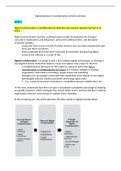Digital business & transformation articles summary
Week 1
Digital transformation: a multidisciplinary reflection and research agenda (Verhoef et al,
2021)
Digital transformation (and the resulting business model innovation) have changed
consumers’ expectations and behaviours, pressured traditional firms, and disrupted
numerous markets.
- Consumers have access to loads of media channels and can easily communicate with
firms and other consumers.
- Many traditional firms have been surpassed by innovative fast-growing digital
entrants and suffered as a result of this.
Digital transformation = a change in how a firm employs digital technologies, to develop a
new digital business model that helps to create and capture more value for the firm.
- A multidisciplinary discussion on this subject is required, given that digital
transformation is multidisciplinary by nature as it involves changes in strategy,
organisation, information technology, supply chains and marketing.
- Managers are increasingly confronted with responding to the advent of new digital
technologies that blur market boundaries and change agent roles.
E.g., customers become co-producers, competitors become collaborators, etc.
We must understand how firms can gain a sustainable competitive advantage by building
on specific resources, which strategies they should adopt to win, and how the firm’s internal
organisation structure must change to support these strategies.
In the remaining part, the article describes this flow model on digital transformation:
,THE NEED FOR DIGITAL TRANSFORMATION
Three major external factors are identified as drivers for digital transformation.
1) Digital technology
- The presence of big data and advent of emerging digital technologies, such as
Artificial Intelligence (AI), are projected to have far-reaching effects on business.
- The wide entrance of new digital technologies signals the need for firms to transform
their business digitally, and the new digital technologies may also affect the firm’s
cost structure through replacing costlier humans during service delivery with the help
of robots or virtual agents, or by reducing supply chain costs through the use of AI.
2) Digital competition
- Competition is changing due to new digital technologies.
- Not only has the competition become more global, the intensity has also increased as
big, information-rich firms (Amazon, Alphabet, Apple, Alibaba) start to dominate
numerous industries.
- Top 5 valuable firms of the S&P 500 Index were all digital in 2018, whereas only 1 out
of 5 was digital just a decade ago.
3) Digital customer behaviour
- Consumer behaviour changes as a response to digital revolution.
- Purchases are shifted to online stores, and digital touchpoints have an important role
in the customer journey affecting both online and offline sales.
- Digital technologies allow consumers to co-create value by designing and customising
products, perform last-mile distribution activities, and help other customers by
sharing product reviews.
- Consumers also strongly rely on apps and new AI-based technologies, like Google
Home, that are entering consumers’ lives.
- If firms cannot adapt to these changes, they become less attractive to customers, and
are likely to be replaced by firms that do leverage such technologies.
THE PHASES OF DIGITAL TRANSFORMATION
The authors identify three phases of digital transformation:
1) Digitisation = the encoding of analogue information into a digital format (i.e., into
zeros and ones) such that computers can store, processes and transmit such
information.
- Growth strategies: market penetration, market development, product development.
- Describes the action to convert analogue information into digital information.
- Digitisation mainly digitalises internal and external documentation processes but
does not change value creation activities.
- E.g., the use of digital forms in ordering processes, use of digital surveys; the use of
digital applications for internal financial declarations; or automated routines and
tasks.
, 2) Digitalisation = describes how IT or digital technologies can be used to alter existing
business processes.
- Growth strategies: market penetration, market development, product development
+ platform-based market penetration, co-creation platform.
- E.g., creation of new online or mobile communication channels that allow all
customers to easily connect with firms, and which change traditional firm-customer
interactions; or use of robots in production.
- IT serves as a key enabler to seize new business possibilities by changing existing
business processes, such as communication, distribution, or business relationship
management.
- Firms apply digital technologies to optimise existing business processes by allowing
more efficient coordination between processes, and/or by creating additional
customer value through enhancing user experiences.
Not only focused on cost savings, but also includes process improvements that
may enhance customer experiences.
3) Digital transformation = a company-wide change that leads to the development of
new business models, which may be new to the focal firm or industry.
- Growth strategies: market penetration, market development, product development
+ platform-based market penetration, co-creation platform + platform diversification.
- The core business model of the firm is subject to change through the use of digital
technology (e.g., ‘product-as-a-service’).
- Affects the whole company and its ways of doing business and goes beyond
digitalisation, which is the changing of simple organisational processes and tasks.
- Use of IT here leads to fundamental changes to existing business processes, routines,
and capabilities, and allow users to enter new or exit current markets.
- Can help to attain a competitive advantage by transforming the organisation to
leverage existing core competences or develop new ones.
Digital transformation particularly relevant for incumbent firms (i.e., those already
established), since they will face challenges and barriers when searching and implementing
business model innovation for digital transformation.
- Incumbent firms often forced to deal with conflicts and trade-offs between existing
and new ways of doing business.
- Move to digital may often require a departure from the status quo and may lead to
obsolesce of existing business models.
STRATEGIC IMPERATIVES OF DIGITAL TRANSFORMATION
1) Digital resources
- Resources represent a firm’s ownership and control of assets – the firm’s resource
endowments in physical and intellectual assets – and capabilities – reside in the
firm’s human, information, or organisational capital and glue assets together to
enable their successful deployment.
- Most important digital assets and capabilities needed for digital change:





